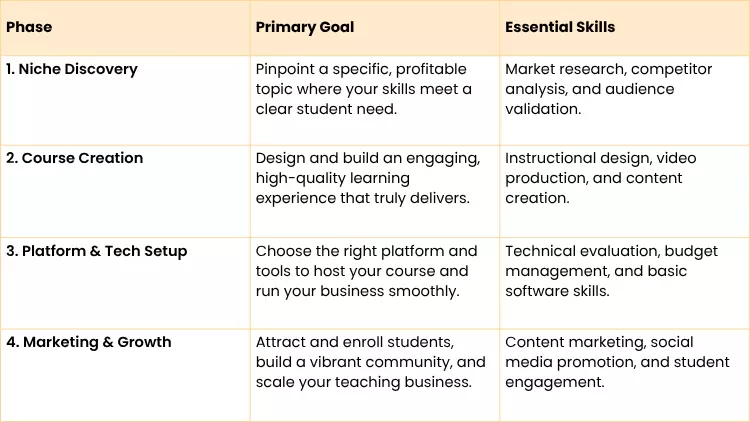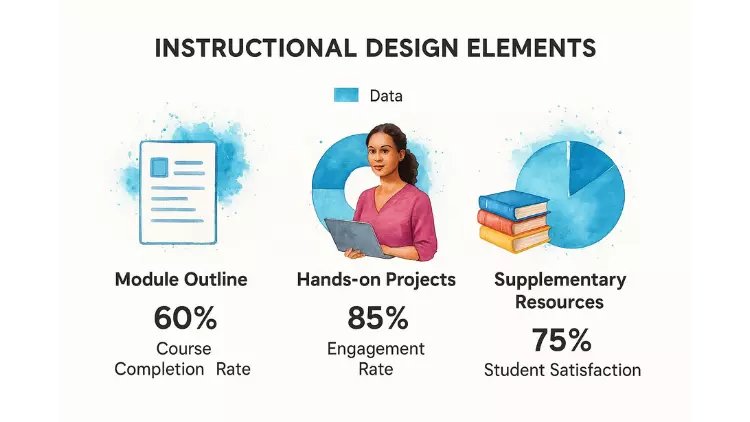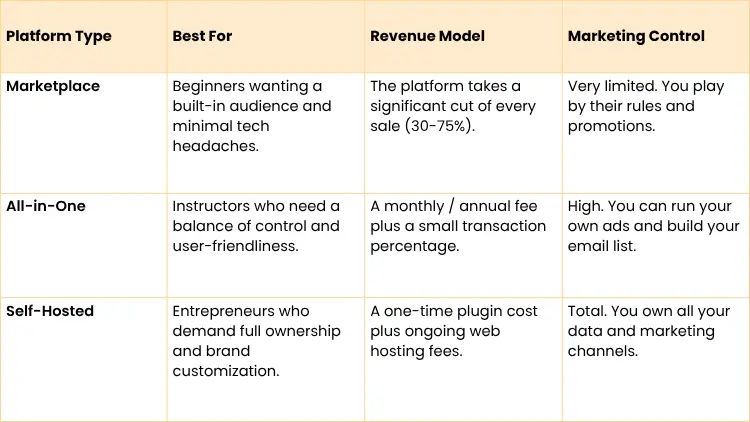How to Become an Online Teacher: Your Success Guide

So, you have a skill you want to share with a wider audience? Fantastic. The path to becoming a successful online instructor is wide open, and it's not just for people with formal teaching degrees. It's for anyone with a practical skill, from marketing gurus to master gardeners, who's ready to package their expertise into something valuable.
Let's walk through the roadmap to turn that passion of yours into a thriving online teaching career.
Jump To Section

Earn As You Learn
Earn 25% commission when your network purchase Uplyrn courses or subscribe to our annual membership. It’s the best thing ever. Next to learning,
of course.
Your Path to Becoming an Online Teacher
If you're wondering whether this is the right time, the answer is a resounding yes. We're seeing a massive global shift to digital learning, and the numbers are staggering. The e-learning market is on track to hit a mind-boggling $1 trillion by 2032. This isn't just a trend; it's a fundamental change in how people learn, and it's creating huge opportunities for new instructors.
The journey is less about credentials and more about creating a genuine learning experience. It's about taking what you know from real-world experience and making it accessible. In many ways, the process is very similar to the steps you'd take if you were figuring out how to start an online coaching business—it all comes down to building authority and delivering real results for your students.

The Four Core Phases of an Online Teaching Career
To make this journey less daunting, we've broken it down into four distinct phases. Think of this as your high-level flight plan before we get into the nitty-gritty. Each stage builds on the one before it, guiding you from that first spark of an idea all the way to a successful launch.
Here’s a quick look at what’s ahead.
Seeing it laid out like this helps clarify the path forward. You don’t have to do it all at once; you just have to focus on the phase you're in.
Actionable Insight: Don't just pick a topic you love; validate it. For example, instead of a generic "Photoshop for Beginners" course, search YouTube for "Photoshop for real estate agents". If the content you find is limited or low-quality, you might have just stumbled upon a profitable, underserved niche.

Discovering Your Profitable Teaching Niche
The first step on your journey to becoming a successful online instructor is a big one: choosing your niche. It's a decision that can genuinely make or break your entire effort. While it's tempting to just teach what you're passionate about, passion alone doesn't pay the bills. The sweet spot is where your expertise, your enthusiasm, and real market demand all meet.
A profitable niche isn’t just a broad topic; it's a specific solution for a specific group of people. Think less "graphic design" and more "Canva animation for small business owners". This super-targeted approach makes finding your ideal students so much easier and lets you become the go-to expert in a smaller, more manageable pond.
Moving Beyond Brainstorming to Validation
Coming up with ideas is the fun part. The real work—and the step most aspiring creators skip—is validating whether people will actually open their wallets to learn what you know. This is what separates a hobby from a viable business.
Start by thinking about the problems you solve for people every day. What are you the "go-to" person for? What skills have you used to get tangible results in your own life or career? These are the seeds of a fantastic course. Once you've got a list, it’s time to see if they hold up in the real world.
Of course, a great way to ensure you always have something valuable to teach is to constantly gain expertise in your areas of interest. This keeps you ahead of the curve and ensures you have unique insights to share.
Using Simple Tools for Market Research
You don't need a massive budget or fancy software to figure out what people are looking for. Some of the best tools for market research are completely free and right at your fingertips.
A great place to start is basic keyword research. Fire up Google or YouTube and just start typing. The autocomplete suggestions are a direct line into the minds of your potential students, revealing the exact phrases they're using to find help.
Let's say you type in "how to learn piano for..." You might see suggestions pop up like:
- ...adult beginners
- ...worship music
- ...jazz improvisation
- ...producers
Each of those suggestions is a potential niche. They're all far more specific—and marketable—than a generic "piano lessons" course.
Analyzing the Competition to Find Your Angle
Once you have a potential topic, it's time to do a little recon. Head over to online learning platforms or even just YouTube and search for your course idea. See what the top results are.
Don't panic if you see other courses! Competition is actually a good thing. It proves there's a paying market for your topic. Your mission isn't to find an idea with zero competition, but to find an opportunity to do something different or better.
Practical Example: You're a project management pro. A quick search shows hundreds of courses on "PMP certification". But as you dig deeper, you notice almost nobody is teaching "Asana for creative agencies". That's your gap. You can build a course specifically for that audience, using their language and solving their unique problems, like "how to manage a video production timeline" or "tracking client feedback on design mockups".
When you're looking at competing courses, ask yourself a few key questions:
- What are they doing well? Take note of their curriculum and what topics they cover in depth.
- What are they missing? The real gold is in the 1, 2, and 3-star reviews. Students will tell you exactly what was missing, confusing, or poorly explained.
- Who is this for? Look at their language. Are they targeting corporate climbers, freelancers, or total beginners? Maybe you can serve a different slice of that audience.
Confirming Your Idea with Real People
Alright, this is the final and most crucial step in validating your idea: actually talking to people. All the research in the world is just a hypothesis until you get direct feedback from your potential students.
Find the online communities where your target audience already gathers. This could be Facebook groups, specific subreddits, LinkedIn groups, or niche forums. Your first move isn't to pitch your course. Just show up, listen, and be helpful.
Actionable Insight:
- Ask open-ended questions. Instead of "Would you buy a course on X?" try asking, "What's your biggest challenge when it comes to X?" For example, in a gardening group, ask "What's the one vegetable you always struggle to grow, and why do you think that is?"
- Provide free value. Answer questions and share your knowledge to build trust and authority. Share a quick tip on pest control or a link to your favorite soil testing kit.
- Run a simple poll. Once you've built a little rapport, you can post a poll asking which of a few topics they'd find most helpful. For example: "I'm thinking of creating a guide for new gardeners. Which topic would help you most? A) Starting a container garden, B) Composting basics, C) Natural pest control."
This kind of direct engagement does more than just validate your idea. It helps you build a waitlist of excited, ready-to-buy students before you've even hit "record", giving you a massive boost of motivation to move forward.

Crafting an Unforgettable Learning Experience
A truly great online course is far more than a collection of video lectures. It's a carefully structured journey that takes a student from where they are to where they want to be. The secret to making that journey memorable and effective lies in solid instructional design—the architecture of learning.
To become an online instructor who gets rave reviews, your focus has to shift. Stop thinking about just presenting information and start engineering a transformative experience for your students.
Outlining for Transformation, Not Just Information
This whole process kicks off with your curriculum outline. Don't just list topics; think in terms of modules, with each one centered around a clear, achievable learning objective. This modular approach breaks down complex subjects into manageable, confidence-building steps. A student shouldn't just finish a module; they should feel a real sense of accomplishment, knowing they've mastered a specific skill.
The goal here is to create a logical flow that builds momentum. Each lesson should connect to the last and set the stage for the next. Think of it like a story with a beginning, a middle, and a satisfying conclusion.
For instance, a course on "Introduction to Podcasting" could be structured like this:
- Module 1 Objective: Understand the podcasting landscape and nail down a unique show concept.
- Module 2 Objective: Select and set up essential recording equipment without breaking the bank.
- Module 3 Objective: Record and edit a high-quality audio segment using free software.
- Module 4 Objective: Create a launch plan and publish the very first episode.
This structure gives students a clear roadmap. They know exactly what they’re learning and why it matters, which is a powerful motivator to keep them going. For a deeper dive into structuring your content, check out these 12 course design questions that impact user experience.
Scripting Videos That Connect and Engage
Once your structure is solid, it's time to think about content delivery, especially video. So many new instructors make the classic mistake of reading from a dry, robotic script. Your real goal is to create a personal connection, making students feel like they have a dedicated mentor guiding them through the material.
Scripting is still crucial, but it should be your guide, not a teleprompter. Use bullet points for key ideas rather than writing out every single word. This simple shift allows your personality to shine through and creates a more natural, conversational tone.
Actionable Insight: Before recording, practice explaining your lesson's main point to an imaginary friend in 30 seconds. This "elevator pitch" approach forces you to be clear and concise. If you can't explain it simply, your script is too complicated.
To really nail this, it's vital to apply instructional design best practices. This means getting into the weeds of how people actually learn and applying those principles to your course structure and content.
This infographic shows just how much these elements can move the needle on student success.
As you can see, a solid outline is foundational. But look at what happens when you add hands-on projects—engagement shoots up, which is a huge factor in whether students actually finish the course.

Beyond Videos: Building Confidence with Hands-On Projects
Let's be honest: passive learning, like just watching videos, has its limits. True mastery comes from doing. This is where hands-on projects and activities become your most powerful teaching tools. They bridge that critical gap between theory and application, giving students the "I did it!" moment that cements their learning for good.
For example, a 'Beginner's Python' course shouldn't just explain code; it should have students build their own simple web scraper by the end. A 'Social Media Marketing' course could have students create and manage a mock ad campaign with a small, provided budget. These practical tasks build real-world skills and, just as importantly, massive confidence.
Despite the proven effectiveness, many instructors worry about replicating the classroom connection online. A recent survey revealed that 55% of instructors still prefer traditional formats because they’re concerned about a weaker teacher-student connection. This highlights a massive opportunity for you: if you can master virtual engagement, you’ll stand out and create a deeply loyal student base.
To make these projects even more effective, create supplemental resources that add value and cater to different learning styles. Think about things like:
- Checklists: For a course on podcasting, provide a "Podcast Launch Checklist" with every single step, from buying a domain name to submitting the RSS feed to Apple Podcasts.
- Templates: A course on email marketing could include a pre-built "Welcome Series Template" in a Google Doc that students can copy and customize.
- Worksheets: For a course on personal finance, create a worksheet that guides students through calculating their net worth and setting financial goals.
These resources don't just support the learning; they become tangible takeaways that students can use long after the course is over, reinforcing the value you provide. By ensuring students don't just watch but achieve, you create an experience they will remember and recommend.
Choosing Your Platform and Tech Toolkit
Alright, you've mapped out your course. Now for the million-dollar question: where will it live, and what will you use to build it? This is a huge stumbling block for many creators. They picture a Hollywood-level production studio and a custom-coded website, and the overwhelm kicks in.
Let’s clear that up right now. The reality is much, much simpler. Your tech choices will shape everything from your income potential to your marketing freedom, so it's about finding the right fit for your goals, not just the fanciest gear.
Where Should You Host Your Course?
Your first big decision is whether to use an established course marketplace or go the self-hosted route. Each has some serious pros and cons, and the right answer really depends on what kind of instructor you want to be.
- Course Marketplaces: Their main draw? A massive, built-in audience of people actively looking to learn. For a brand-new instructor, this is a game-changer because the platform does a lot of the heavy lifting on marketing and payment processing.
- Self-Hosted Solutions: This path gives you total control. You’d use tools like a LearnDash plugin on a WordPress site. Here, you own everything: the branding, the pricing, your student list, and your marketing. The trade-off is that you're 100% responsible for bringing in your own audience.
Practical Example: An instructor teaching a niche hobby like "Vintage Photo Restoration in Photoshop" could do brilliantly on a marketplace. Students are already there, browsing for that exact kind of skill. But if you're building a flagship "Digital Marketing MBA" program, you’ll probably want a self-hosted platform to cultivate a premium brand and own the entire student experience from start to finish.
Comparing Online Course Platform Options
To help you decide, here's a quick breakdown of the main differences between these platform types. Think about where you are right now and where you want to be in a year.
No matter which path you choose, the industry is booming, especially for live instruction. The online instructor-led training space hit $41.3 billion in 2024 and is projected to explode to nearly $139 billion by 2030. Picking a platform like Uplyrn that supports live sessions could be a very smart move.

Building Your Starter Tech Toolkit on a Budget
Here's the best news you'll hear all day: you do not need to drop thousands of dollars on equipment. Your entire focus should be on two things: crystal-clear audio and clean, simple visuals. Trust us, bad audio is infinitely more distracting than a video that isn't 4K.
You can get professional-grade results with a surprisingly lean and budget-friendly setup. Here’s all you really need to get started:
- A Good USB Microphone: Audio is the one thing you can't skimp on. A solid USB mic like the Blue Yeti or Audio-Technica AT2020 plugs right into your computer and makes you sound crisp and professional. It’s a night-and-day difference from your laptop’s built-in mic.
- Screen Recording Software: You'll need a way to record your slides or software demos. OBS Studio is an incredibly powerful tool that is 100% free for both Mac and Windows. It lets you easily record your screen, your webcam, and your audio all at once. If you want to explore more options, there are some great roundups of the best apps to record lectures available.
- Simple Video Editing Software: Forget about complicated professional suites. Free tools like DaVinci Resolve (which has a fantastic free version) or super-intuitive apps like the desktop version of CapCut are more than powerful enough. They can handle all the basics, like trimming out your "ums" and "ahs" and adding simple text on screen.
That's it. This basic kit is all you need to create a course that provides immense value. For a deeper dive, check out this guide on 6 fantastic tools for any distance learning system.
Start smart. Focus your energy on creating amazing content, and let the tech simply be the tool that helps you share it. You can always upgrade your camera or lighting down the road once the revenue starts coming in.
Marketing Your Course and Finding Your First Students
Building an amazing course is a huge milestone, but it's only half the journey. The real work begins when it's time to get that course into the hands of students who need it. Your job isn't done until people are enrolling, learning, and seeing real results.
Marketing can sound like a big, scary word, but it really just boils down to one thing: making genuine connections with people who are struggling with the exact problem you solve.
You don't need a massive budget or a complicated spreadsheet to get started. In fact, some of the most powerful marketing tactics are completely free and revolve around being genuinely helpful long before you ever ask for a sale.
Building Trust with Content Marketing
The absolute best way to sell a course is to prove you know what you're talking about. That's the whole idea behind content marketing. You create and share valuable, free stuff—like blog posts, short video tutorials, or handy checklists—that solves a small piece of your audience's bigger problem.
This builds an incredible amount of trust and naturally positions you as the go-to expert in your field. Think about it: if someone learns something valuable from your free content, they'll immediately start to wonder what kind of transformation is possible inside your full course.
Let's say a freelance web developer creates a course called "Building a Killer Portfolio Site". They could start a simple blog and write articles like:
- "5 Rookie Mistakes to Avoid on Your First Portfolio"
- "A Quick Guide to Choosing a Brand Color Palette That Doesn't Suck"
- "How to Write Project Case Studies That Actually Land You Clients"
Every one of those posts delivers a quick win and attracts the perfect person for their paid course. This is a core part of a much bigger strategy, and you can dive deeper by checking out this complete guide for selling online courses.
Engineering a Successful Course Launch
A great launch doesn't just happen by accident. It's a carefully planned event designed to build a wave of excitement and drive those crucial first sales. A simple pre-launch plan can be the difference between a flood of new students and the dreaded sound of crickets.
The goal is to get a small, dedicated group of people excited before your course even goes on sale. Start talking about what you're creating about 2-4 weeks before your launch date. Post behind-the-scenes photos of your recording setup on social media or ask your email list for feedback on your course outline.
This pre-launch buzz all leads up to launch week. Here's a simple but effective game plan:
- Open with an Early-Bird Offer: For the first 48-72 hours, offer a special discount just for your earliest supporters. This creates a sense of urgency and rewards the people who've been following your journey from the start.
- Focus on the Transformation: In your emails and social posts, talk less about the features (e.g., "10 hours of video") and more about the outcome. What will your student be able to do after they finish?
- Close with Urgency: As the launch window ends, send a final reminder that the special price is expiring. You'd be surprised how many sales come in during this final push.
Practical Example: An instructor launching a "Beginner's Guide to Sourdough Baking" could create a pre-launch email list by offering a free PDF on "5 Essential Sourdough Tools". They can then email that list an exclusive early-bird discount a week before the public launch, guaranteeing a first wave of super-engaged students.
Finding Your Students Where They Already Are
Don't try to be everywhere at once. It's a recipe for burnout. The key is to figure out where your ideal students already hang out online and simply show up there. The right platform is completely dependent on your niche.
- LinkedIn: The go-to for any course on professional skills. Think project management, public speaking, or B2B sales. Share insightful text posts and articles that help people level up their careers.
- Instagram: A visual playground perfect for creative skills like photography, watercolor painting, or graphic design. Use Reels to share quick tips and showcase stunning student work.
- YouTube: The ultimate platform for anything that benefits from a step-by-step tutorial. If you teach software, coding, a craft, or a musical instrument, this is your spot.
- Facebook Groups: A goldmine for hobby or community-focused topics. From gardening and parenting to learning guitar, there's a group for everything.
Once you pick a platform, your only job is to be helpful. Answer questions. Participate in discussions. Share your free content without being spammy. It’s not about dropping links; it's about becoming a trusted, recognized voice in that community.
Turning Students into Your Best Marketers
Your happiest students are, without a doubt, your most powerful marketing asset. A glowing testimonial from someone who got real results with your course is more convincing than any Facebook ad you could ever run.
From day one, build feedback collection into your process. When a student finishes your course, have a simple, automated email go out asking about their experience.
To get testimonials that really pack a punch, ask specific questions:
- What was your biggest challenge before you took this course?
- What was a specific "aha" moment you had while learning?
- How has this new skill actually impacted your life or work?
Actionable Insight: Create a simple Google Form with these questions and link to it in your final "Congratulations!" email. To increase responses, offer a small incentive, like a 10% discount on a future course or a bonus resource, for everyone who completes the form.
Plaster these testimonials everywhere—on your sales page, in your marketing emails, and on social media. They provide powerful social proof that gives potential students the confidence they need to hit that "enroll" button, creating a flywheel of success that will fuel your course for years to come.

Answering Your Top Questions About Teaching Online
When you're thinking about creating an online course, a few big questions always seem to pop up. It's totally normal. Getting some straight answers can be the difference between staying stuck on the sidelines and finally diving in. Let's tackle the most common ones we hear from people just starting out.
Do I Need a Formal Teaching Degree?
Let's get this one out of the way immediately: absolutely not. For the vast majority of online courses, especially those you'd sell on your own site or a marketplace, students aren't looking for a professor. They're looking for a practitioner.
What really matters is your real-world experience. A killer portfolio, years of hands-on practice, or a proven track record in your field carries way more weight than a formal teaching certificate. People are actively seeking out experts—those who have actually done the thing they want to learn how to do. Your authority comes from your experience, not a diploma.
How Much Can I Realistically Earn?
This is the million-dollar question, isn't it? The honest answer is that it varies wildly. Your income could be anything from a few hundred dollars a month on the side to a full-blown, six-figure business. You're essentially an entrepreneur, so there's no set salary.
A few key things will determine your earning potential:
- Your Niche: Is there a big, hungry audience willing to pay for what you know?
- Your Pricing: Are you offering a small $50 mini-course or a signature program for $500 or more?
- Your Marketing Chops: How good are you at getting your course in front of the right people?
- Your Platform: Selling on a marketplace like Udemy gives you access to their audience, but they take a hefty cut.
If you host the course yourself, you keep almost all the revenue, but you're on the hook for all the marketing. For a little perspective, industry data shows an adjunct professor teaching a single college course earns around $2,700 per course. While not a perfect comparison, it gives you a benchmark for what a single course can be worth in a more traditional setting.
How Long Does It Take to Create and Launch a Course?
There's no single answer, but a good rule of thumb for a solid, 2-3 hour video course is somewhere between 40 and 80 hours of focused work. That's a realistic window that covers everything from start to finish.
Practical Example: This breaks down roughly into 10 hours for research and outlining, 15 hours for creating slides/resources, 20 hours for recording, 25 hours for editing, and 10 hours for writing sales copy and setting up the launch. You can fit this into 10 hours a week over two months.
If you're planning a massive flagship course, you could easily be looking at 200+ hours spread out over several months. That's a huge commitment, which is why we always advise first-timers to think smaller.
Starting with a focused "beta" course is a brilliant move. You can test your idea and teaching style with a small group of founding students before you sink hundreds of hours into a giant project. This strategy helps you build momentum, gather priceless feedback, and get your first testimonials in the bag.
Ready to stop wondering and start building? At Uplyrn, we provide the tools and community you need to turn your expertise into a successful online course. Join over tens of thousands of satisfied learners and instructors on a platform built for growth. Start creating your course today on Uplyrn.


Leave your thoughts here...
All Comments
Reply